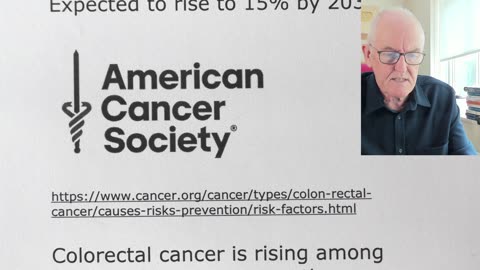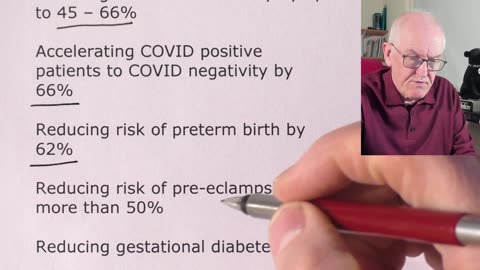-
Colon cancer in the young
 Dr. John CampbellColon cancer Breast, prostate, lung, bowel, melanoma, kidney, lymphoma Cause of cancer deaths, lung bowel US data, 10.5% of newly diagnosed colorectal cancers now occur in people younger than 50 Expected to rise to 15% by 2030 https://www.cancer.org/cancer/types/colon-rectal-cancer/causes-risks-prevention/risk-factors.html Colorectal cancer is rising among people who are younger than age 50, and the reason for this remains unclear. https://pmc.ncbi.nlm.nih.gov/articles/PMC9177054/ Index of suspicion at younger age Anaemia, (red flag), SOBE, fatigue, pallor Abdominal pain, bloating Diarrhoea or constipation Change in normal bowel habit, (looser, more or less often), 3 weeks PR bleed, mixed, streaked, dark and tarry Pencil stools Feeling of fullness after passing stool Straining Abdo or back passage pain Lumps or obstruction Weight loss DVT Aetiology Obesity Physical activity DM2 Diet Microbiome, probiotics, prebiotics Vitamin D Smoking Alcohol Microplastics Personal and family history Adenomatous polyps Inflammatory bowel disease Lynch syndrome, hereditary non-polyposis colon cancer or (HNPCC) mRNA injections11.7K views 8 comments
Dr. John CampbellColon cancer Breast, prostate, lung, bowel, melanoma, kidney, lymphoma Cause of cancer deaths, lung bowel US data, 10.5% of newly diagnosed colorectal cancers now occur in people younger than 50 Expected to rise to 15% by 2030 https://www.cancer.org/cancer/types/colon-rectal-cancer/causes-risks-prevention/risk-factors.html Colorectal cancer is rising among people who are younger than age 50, and the reason for this remains unclear. https://pmc.ncbi.nlm.nih.gov/articles/PMC9177054/ Index of suspicion at younger age Anaemia, (red flag), SOBE, fatigue, pallor Abdominal pain, bloating Diarrhoea or constipation Change in normal bowel habit, (looser, more or less often), 3 weeks PR bleed, mixed, streaked, dark and tarry Pencil stools Feeling of fullness after passing stool Straining Abdo or back passage pain Lumps or obstruction Weight loss DVT Aetiology Obesity Physical activity DM2 Diet Microbiome, probiotics, prebiotics Vitamin D Smoking Alcohol Microplastics Personal and family history Adenomatous polyps Inflammatory bowel disease Lynch syndrome, hereditary non-polyposis colon cancer or (HNPCC) mRNA injections11.7K views 8 comments -
Causes of disease in children
 Dr. John CampbellObesity, diabetes, cancers, asthma, allergies, autoimmune diseases, behavioral disorders. Drivers a combination of factors, food, chemical exposure, medications, changes in lifestyle and behavior, physical activity, sleep, the use of technology. The food American children are eating Most American children’s diets are dominated by ultra-processed foods (UPFs) Lacking sufficient intakes of fruits and vegetables. UPFs has led to a depletion of essential micronutrients and dietary fiber (Vit D, Bs and C, Zn, Mg, Se, I, omega 3s, amino acids) Nearly 70% of an American child’s calories today comes from ultra-processed food, many of which are designed to override satiety (increased from zero 100 years ago) UPFs makeup over 50% of the diets of pregnant and postpartum mothers. American children’s exposure to environmental chemicals Cumulative load of thousands of synthetic chemicals From food, water, air Including neurodevelopmental and endocrine effects. Over 40,000 chemicals are registered for use in the U.S. Pesticides, microplastics, dioxins, commonly found in blood and urine of children and pregnant women—some at alarming levels. Children are particularly vulnerable to chemicals Utero, infancy, early childhood, and puberty. Current risk assessment methods, may not allow us to fully understand how these exposures affect human health. Children’s pervasive technology use Past 40 years Over the past four decades, children have transitioned from an active, play-based childhood to a sedentary, technology-driven lifestyle. Specifically, increased screen time, reduced physical activity, psychosocial stressors like loneliness, chronic stress, and sleep deprivation. Teens average nearly 9 hours of non-school screen time each day. Over 70% of children, and 85% of teens, fail to meet the 2024 federal guideline of 60 minutes of daily moderate-to-vigorous physical activity. Nearly 80% of U.S. high school students do not sleep at least 8 hours per night, up from 69% in 2009. 2009, 69% high school students do not sleep at least 8 hours per night Now its 80% Persistent sadness and hopelessness among U.S. high school students surged between 2011 to 2021 from 28% to 42% Female students’ suicidal ideation rising from 19% to 30%. In 2024, 73% of 16–24-year-olds reported loneliness, 15% of young men having no close friendships, a fivefold increase since 1990. Teens using social media over 3 hours daily face double the risk of anxiety and depression, a 2022 meta-analysis showing each additional hour increases depression risk by 13% American children are highly medicated – and it’s not working The health system has aggressively responded to these increases in childhood chronic disease with increasing rates of pharmaceutical drug prescriptions, which may cause further harm Stimulant prescriptions for ADHD in the U.S. increased 250% from 2006 to 2016, despite evidence they did not improve outcomes long-term. Antidepressant prescription rates in teens increased by 1,400% between 1987 and 2014, even though a systematic overview shows that psychotherapy is just as effective as drugs in the short term, and potentially more effective in the long term. Antipsychotic prescriptions for children increased by 800% between 1993 and 2009, with most of these medications prescribed for conditions not approved by the FDA for use in children. Studies find that more than 35% (more than 15 million prescriptions) of childhood antibiotics are unnecessary infants exposed to antibiotics in first 2 years of life are more likely to develop asthma, allergic rhinitis, atopic dermatitis, celiac disease, obesity, and ADHD. Corporate Capture and the Revolving Door Perverse incentives that impact the regulatory bodies and federal agencies tasked with overseeing them Government funding has been a small portion of the totality of research dollars being spent on chronic childhood disease. The majority is funded by the food, pharmaceutical, and chemical, as well as special interest Non- Governmental Organizations (NGOs) and professional associations. Examples The food industry funds the bulk of research in the field. A BMJ analysis found that industry spent over $60 billion on drug, biotechnology, and device research in nutrition science; by comparison, the government spends an estimated $1.5 billion on nutrition research. Concerningly, industry-funded nutrition research may bias conclusions in favor of sponsors’ products. Moreover, one analysis reported that 95% of the 2020 Dietary Guidelines Advisory Committee members had financial ties to food and pharmaceutical companies. The chemical-manufacturing industry Spent roughly $77 million on federal lobbying activities in 2024, while 60% of their lobbyists previously held federal posts. More than 10,000 thousand chemicals listed on the EPA’s inventory are designated as confidential, and generic chemical names are used to identify them. The pharmaceutical industry, 1999 to 2018 Spent $4.7 billion on lobbying expenditures at the federal level, more than any other industry. 9 out of the last 10 FDA commissioners have gone on to work for the pharmaceutical industry. 70% of FDA the medical reviewers — have gone on to work for the pharmaceutical industry. Over 80% of clinical departments and teaching hospitals at U.S. medical schools receive some degree of pharmaceutical funding, Half of the total costs for continuing medical education (CME) is funded by industry. 2010 and 2022 Industry provided $6 billion to over 20,000 patient advocacy organizations.16.2K views 32 comments
Dr. John CampbellObesity, diabetes, cancers, asthma, allergies, autoimmune diseases, behavioral disorders. Drivers a combination of factors, food, chemical exposure, medications, changes in lifestyle and behavior, physical activity, sleep, the use of technology. The food American children are eating Most American children’s diets are dominated by ultra-processed foods (UPFs) Lacking sufficient intakes of fruits and vegetables. UPFs has led to a depletion of essential micronutrients and dietary fiber (Vit D, Bs and C, Zn, Mg, Se, I, omega 3s, amino acids) Nearly 70% of an American child’s calories today comes from ultra-processed food, many of which are designed to override satiety (increased from zero 100 years ago) UPFs makeup over 50% of the diets of pregnant and postpartum mothers. American children’s exposure to environmental chemicals Cumulative load of thousands of synthetic chemicals From food, water, air Including neurodevelopmental and endocrine effects. Over 40,000 chemicals are registered for use in the U.S. Pesticides, microplastics, dioxins, commonly found in blood and urine of children and pregnant women—some at alarming levels. Children are particularly vulnerable to chemicals Utero, infancy, early childhood, and puberty. Current risk assessment methods, may not allow us to fully understand how these exposures affect human health. Children’s pervasive technology use Past 40 years Over the past four decades, children have transitioned from an active, play-based childhood to a sedentary, technology-driven lifestyle. Specifically, increased screen time, reduced physical activity, psychosocial stressors like loneliness, chronic stress, and sleep deprivation. Teens average nearly 9 hours of non-school screen time each day. Over 70% of children, and 85% of teens, fail to meet the 2024 federal guideline of 60 minutes of daily moderate-to-vigorous physical activity. Nearly 80% of U.S. high school students do not sleep at least 8 hours per night, up from 69% in 2009. 2009, 69% high school students do not sleep at least 8 hours per night Now its 80% Persistent sadness and hopelessness among U.S. high school students surged between 2011 to 2021 from 28% to 42% Female students’ suicidal ideation rising from 19% to 30%. In 2024, 73% of 16–24-year-olds reported loneliness, 15% of young men having no close friendships, a fivefold increase since 1990. Teens using social media over 3 hours daily face double the risk of anxiety and depression, a 2022 meta-analysis showing each additional hour increases depression risk by 13% American children are highly medicated – and it’s not working The health system has aggressively responded to these increases in childhood chronic disease with increasing rates of pharmaceutical drug prescriptions, which may cause further harm Stimulant prescriptions for ADHD in the U.S. increased 250% from 2006 to 2016, despite evidence they did not improve outcomes long-term. Antidepressant prescription rates in teens increased by 1,400% between 1987 and 2014, even though a systematic overview shows that psychotherapy is just as effective as drugs in the short term, and potentially more effective in the long term. Antipsychotic prescriptions for children increased by 800% between 1993 and 2009, with most of these medications prescribed for conditions not approved by the FDA for use in children. Studies find that more than 35% (more than 15 million prescriptions) of childhood antibiotics are unnecessary infants exposed to antibiotics in first 2 years of life are more likely to develop asthma, allergic rhinitis, atopic dermatitis, celiac disease, obesity, and ADHD. Corporate Capture and the Revolving Door Perverse incentives that impact the regulatory bodies and federal agencies tasked with overseeing them Government funding has been a small portion of the totality of research dollars being spent on chronic childhood disease. The majority is funded by the food, pharmaceutical, and chemical, as well as special interest Non- Governmental Organizations (NGOs) and professional associations. Examples The food industry funds the bulk of research in the field. A BMJ analysis found that industry spent over $60 billion on drug, biotechnology, and device research in nutrition science; by comparison, the government spends an estimated $1.5 billion on nutrition research. Concerningly, industry-funded nutrition research may bias conclusions in favor of sponsors’ products. Moreover, one analysis reported that 95% of the 2020 Dietary Guidelines Advisory Committee members had financial ties to food and pharmaceutical companies. The chemical-manufacturing industry Spent roughly $77 million on federal lobbying activities in 2024, while 60% of their lobbyists previously held federal posts. More than 10,000 thousand chemicals listed on the EPA’s inventory are designated as confidential, and generic chemical names are used to identify them. The pharmaceutical industry, 1999 to 2018 Spent $4.7 billion on lobbying expenditures at the federal level, more than any other industry. 9 out of the last 10 FDA commissioners have gone on to work for the pharmaceutical industry. 70% of FDA the medical reviewers — have gone on to work for the pharmaceutical industry. Over 80% of clinical departments and teaching hospitals at U.S. medical schools receive some degree of pharmaceutical funding, Half of the total costs for continuing medical education (CME) is funded by industry. 2010 and 2022 Industry provided $6 billion to over 20,000 patient advocacy organizations.16.2K views 32 comments -
Children's health crisis is real
 Dr. John CampbellAmerican children, health crisis Today’s children are the sickest generation in American history in terms of chronic disease Obesity, heart disease, diabetes, cancers, asthma, allergies, autoimmune diseases, behavioral disorders. Preventable trends continue to worsen each year https://www.whitehouse.gov/maha/ Federal and state policy have sometimes been guided more by corporate profit than the public interest. Scientific and medical institutions, complacent, defaulting to symptom management. We need gold-standard science to prevent and reverse root causes. The U.S. food and agricultural systems, embraced ultra-processed ingredients and synthetic chemicals. Healthcare system has over-medicalized children, frequently masking and compounding underlying issues. Rising screen addiction and sedentary lifestyles Chronically stressed, sick, and isolated generation. Purpose of this report, radical transparency, spur a conversation about how we can build a world Farmers are put at the center of how we think about health. Healthcare system thrives when disease is prevented and reversed, not just “managed”. AI technology that will develop new tools and push the frontiers of science, re. reverse chronic disease. America’s children 73 million children Over 40% (aged 0-17) in US, at least one chronic health condition Over 75% of American youth (aged 17- 24) are ineligible for military service, primarily due to obesity, poor physical fitness, and/or mental health challenges. More than 1 in 5 children over 6 years old are obese. More than 270% increase compared to the 1970s 80% of obese teens will become obese adults 70% of youth with obesity already have at least one risk factor for heart disease Both type 1 and type 2 diabetes have consistently increased the past 2 decades By 2060 if current DM trends continue 65% increase in type 1 diabetes 600% increase in type 2 diabetes Autism spectrum disorder impacts 1 in 31 children by age 8, Over 10% of children have been diagnosed with Attention Deficit Hyperactivity Disorder (ADHD) (1 million more children diagnosed in 2022 compared to 2016) Rates of other neurodevelopmental disorders and learning impairments are also increasing. Over 7.5 million (over 10%) K-12 students received special education services in 2023-24 Childhood cancer incidence has risen over 40% since 1975 Teenage depression rates nearly doubled from 2009 to 2019 More than 1 in 4 teenage girls in 2022 reporting a major depressive episode in the past year Three million high school students seriously considered suicide in 2023 Diagnosed anxiety increased by 61% among adolescents between 2016 and 2023. Over 57% of girls report feelings of sadness and hopelessness From 2007 to 2021 Suicide deaths among 10- to 24-year-olds increased by 62% Suicide deaths among 10- to 24-year-olds increased by 62% Suicide is now the second leading cause of death in teens aged 15-19. Over 1 in 4 American children suffers from allergies Eczema (atopic dermatitis), 12.7% of children Between 1997 and 2018, childhood food-allergy prevalence rose 88%. Celiac disease rates have increased 5-fold in American children since the 1980s. Rates of Inflammatory Bowel Disease (IBD), including Crohn’s, have increased by 25% over the last decade. Factors Food Exposure to environmental chemicals Pervasive technology use Children are highly medicated – and it’s not working17.8K views 58 comments
Dr. John CampbellAmerican children, health crisis Today’s children are the sickest generation in American history in terms of chronic disease Obesity, heart disease, diabetes, cancers, asthma, allergies, autoimmune diseases, behavioral disorders. Preventable trends continue to worsen each year https://www.whitehouse.gov/maha/ Federal and state policy have sometimes been guided more by corporate profit than the public interest. Scientific and medical institutions, complacent, defaulting to symptom management. We need gold-standard science to prevent and reverse root causes. The U.S. food and agricultural systems, embraced ultra-processed ingredients and synthetic chemicals. Healthcare system has over-medicalized children, frequently masking and compounding underlying issues. Rising screen addiction and sedentary lifestyles Chronically stressed, sick, and isolated generation. Purpose of this report, radical transparency, spur a conversation about how we can build a world Farmers are put at the center of how we think about health. Healthcare system thrives when disease is prevented and reversed, not just “managed”. AI technology that will develop new tools and push the frontiers of science, re. reverse chronic disease. America’s children 73 million children Over 40% (aged 0-17) in US, at least one chronic health condition Over 75% of American youth (aged 17- 24) are ineligible for military service, primarily due to obesity, poor physical fitness, and/or mental health challenges. More than 1 in 5 children over 6 years old are obese. More than 270% increase compared to the 1970s 80% of obese teens will become obese adults 70% of youth with obesity already have at least one risk factor for heart disease Both type 1 and type 2 diabetes have consistently increased the past 2 decades By 2060 if current DM trends continue 65% increase in type 1 diabetes 600% increase in type 2 diabetes Autism spectrum disorder impacts 1 in 31 children by age 8, Over 10% of children have been diagnosed with Attention Deficit Hyperactivity Disorder (ADHD) (1 million more children diagnosed in 2022 compared to 2016) Rates of other neurodevelopmental disorders and learning impairments are also increasing. Over 7.5 million (over 10%) K-12 students received special education services in 2023-24 Childhood cancer incidence has risen over 40% since 1975 Teenage depression rates nearly doubled from 2009 to 2019 More than 1 in 4 teenage girls in 2022 reporting a major depressive episode in the past year Three million high school students seriously considered suicide in 2023 Diagnosed anxiety increased by 61% among adolescents between 2016 and 2023. Over 57% of girls report feelings of sadness and hopelessness From 2007 to 2021 Suicide deaths among 10- to 24-year-olds increased by 62% Suicide deaths among 10- to 24-year-olds increased by 62% Suicide is now the second leading cause of death in teens aged 15-19. Over 1 in 4 American children suffers from allergies Eczema (atopic dermatitis), 12.7% of children Between 1997 and 2018, childhood food-allergy prevalence rose 88%. Celiac disease rates have increased 5-fold in American children since the 1980s. Rates of Inflammatory Bowel Disease (IBD), including Crohn’s, have increased by 25% over the last decade. Factors Food Exposure to environmental chemicals Pervasive technology use Children are highly medicated – and it’s not working17.8K views 58 comments -
Neil, Tim and John, Graveyard talk
 Dr. John CampbellThis talk was inspired by Neil’s book, ‘Hauntings’. I guess its about , time, place, the human condition and possibly more. Graveyard talk with Neil Oliver, Tim Kelly and John Campbell. Get a copy of the book from, https://www.neiloliver.com/ https://www.amazon.co.uk/Hauntings-Ghosts-Across-British-Locations/dp/B0C2JBGWVV/ref=sr_1_4?crid=3QUM6L9FXJR6C&dib=eyJ2IjoiMSJ9.mLbnmQ_DKzkupDJuNsksYwHbszW7C9jz7uZuaO_F5I2m2DMzvo2qgX4fqYauEmyCJU1wJUOA4zrlbxQkPsG0-eher2KWxu8asng3Dlw79tQ-X8CkI-o1rYyctGphXJA78MKvABFbQVap_fG-PY7nAcorf6nf97-GgfseTA7_JC3QrJ6XujGG3Sn0f7Q84a8b64m-Mujt-Ua9tCbwJUKpvHBeCQQ9gXGdSOCDC9sS-6pl4C-QaAJzaAluuKl-9T8EG208yGJmGMEcUxTumBa9fX07XZsm1YEQca_qGQnCfTM.3WyLfxxmnsakN8ZCkXM3Gftl3iADP5uVQjlV6Zxblbk&dib_tag=se&keywords=hauntings+oliver&qid=1748176951&sprefix=hauntings+oliver%2Caps%2C123&sr=8-4 Check out Neil's channel, https://www.youtube.com/@Neil-Oliver Follow Tim on X, https://x.com/DrTimothyKelly17.6K views 57 comments
Dr. John CampbellThis talk was inspired by Neil’s book, ‘Hauntings’. I guess its about , time, place, the human condition and possibly more. Graveyard talk with Neil Oliver, Tim Kelly and John Campbell. Get a copy of the book from, https://www.neiloliver.com/ https://www.amazon.co.uk/Hauntings-Ghosts-Across-British-Locations/dp/B0C2JBGWVV/ref=sr_1_4?crid=3QUM6L9FXJR6C&dib=eyJ2IjoiMSJ9.mLbnmQ_DKzkupDJuNsksYwHbszW7C9jz7uZuaO_F5I2m2DMzvo2qgX4fqYauEmyCJU1wJUOA4zrlbxQkPsG0-eher2KWxu8asng3Dlw79tQ-X8CkI-o1rYyctGphXJA78MKvABFbQVap_fG-PY7nAcorf6nf97-GgfseTA7_JC3QrJ6XujGG3Sn0f7Q84a8b64m-Mujt-Ua9tCbwJUKpvHBeCQQ9gXGdSOCDC9sS-6pl4C-QaAJzaAluuKl-9T8EG208yGJmGMEcUxTumBa9fX07XZsm1YEQca_qGQnCfTM.3WyLfxxmnsakN8ZCkXM3Gftl3iADP5uVQjlV6Zxblbk&dib_tag=se&keywords=hauntings+oliver&qid=1748176951&sprefix=hauntings+oliver%2Caps%2C123&sr=8-4 Check out Neil's channel, https://www.youtube.com/@Neil-Oliver Follow Tim on X, https://x.com/DrTimothyKelly17.6K views 57 comments -
Birth rates lower in vaccinated
 Dr. John CampbellFree downloads of my books, https://drjohncampbell.co.uk Rates of Successful Conceptions According to COVID-19 Vaccination Status: Data from the Czech Republic https://www.preprints.org/manuscript/202504.2487/v1 Birth rates about 30% lower in vaccinated v unvaccinated women 1,300,000 women Total fertility rate in the Czech Republic 2021, 1.83 births per 1000 women 2022, 1.62 births per 1000 women 2023, 1.45 births per 1000 women Declining birth rates have been reported in many countries following the COVID-19 pandemic, and have been linked with economic instability, social inequality, and related social restrictions Adverse effects of COVID-19 vaccination on human menstrual cycle characteristics have been observed, but limited data are available on the relationship between vaccination status and birth rates. We used nationwide data from the Czech Republic To examine rates of successful conceptions i.e., conceptions leading to live births 9 months later, for women, either vaccinated or unvaccinated against COVID-19, before successful conceptions Data from January 2021 to December 2023 Monthly COVID-19 vaccination and birth data for women aged 18-39 years in the Czech Republic Numbers of SCs per month per 1,000 women, preconception-vaccinated or unvaccinated women Pfizer and Moderna mRNA vaccines comprised 96% of all vaccine doses, Results 1,300,000 women aged 18-39 years in the Czech Republic The proportion of COVID-19-vaccinated women increased until reaching a steady state of around 70% by the end of 2021. During the entire study period, SCs per 1,000 women were considerably lower for women who were vaccinated, compared to those that were unvaccinated. At the end of June 2021 39% of all women had been vaccinated, those vaccinated before SC contributed only 7% of all SCs. Furthermore, SC rates for the vaccinated group were generally much lower than expected based on their proportion of the total population. Throughout 2022, SC rates remained about 1.5 times higher for women that were unvaccinated before SC compared with those that were vaccinated before SC Conclusions In the Czech Republic, SC rates were substantially lower for women vaccinated against COVID-19 before SC than for those who were not vaccinated. These hypothesis-generating and preliminary results call for further studies of the potential influence of COVID-19 vaccination on human fecundability and fertility. Unfortunately, the potential influence on reproductive health was not assessed in randomized preauthorization trials of COVID-19 vaccines The Czech Republic is one of the few countries where nationwide birth data are available for women who were vaccinated or unvaccinated for COVID-19, It is possible that more women who wished to become pregnant, i.e., achieve SC, chose not to be vaccinated, and/or that more women who did not plan to become pregnant opted for vaccination. Mechanisms Vaccination may be associated with menstrual pain and changes in menstrual flow and cycle length Direct effects of Pfizer on the ovarian follicle were reported recently. https://drjohncampbell.co.uk22.3K views 106 comments
Dr. John CampbellFree downloads of my books, https://drjohncampbell.co.uk Rates of Successful Conceptions According to COVID-19 Vaccination Status: Data from the Czech Republic https://www.preprints.org/manuscript/202504.2487/v1 Birth rates about 30% lower in vaccinated v unvaccinated women 1,300,000 women Total fertility rate in the Czech Republic 2021, 1.83 births per 1000 women 2022, 1.62 births per 1000 women 2023, 1.45 births per 1000 women Declining birth rates have been reported in many countries following the COVID-19 pandemic, and have been linked with economic instability, social inequality, and related social restrictions Adverse effects of COVID-19 vaccination on human menstrual cycle characteristics have been observed, but limited data are available on the relationship between vaccination status and birth rates. We used nationwide data from the Czech Republic To examine rates of successful conceptions i.e., conceptions leading to live births 9 months later, for women, either vaccinated or unvaccinated against COVID-19, before successful conceptions Data from January 2021 to December 2023 Monthly COVID-19 vaccination and birth data for women aged 18-39 years in the Czech Republic Numbers of SCs per month per 1,000 women, preconception-vaccinated or unvaccinated women Pfizer and Moderna mRNA vaccines comprised 96% of all vaccine doses, Results 1,300,000 women aged 18-39 years in the Czech Republic The proportion of COVID-19-vaccinated women increased until reaching a steady state of around 70% by the end of 2021. During the entire study period, SCs per 1,000 women were considerably lower for women who were vaccinated, compared to those that were unvaccinated. At the end of June 2021 39% of all women had been vaccinated, those vaccinated before SC contributed only 7% of all SCs. Furthermore, SC rates for the vaccinated group were generally much lower than expected based on their proportion of the total population. Throughout 2022, SC rates remained about 1.5 times higher for women that were unvaccinated before SC compared with those that were vaccinated before SC Conclusions In the Czech Republic, SC rates were substantially lower for women vaccinated against COVID-19 before SC than for those who were not vaccinated. These hypothesis-generating and preliminary results call for further studies of the potential influence of COVID-19 vaccination on human fecundability and fertility. Unfortunately, the potential influence on reproductive health was not assessed in randomized preauthorization trials of COVID-19 vaccines The Czech Republic is one of the few countries where nationwide birth data are available for women who were vaccinated or unvaccinated for COVID-19, It is possible that more women who wished to become pregnant, i.e., achieve SC, chose not to be vaccinated, and/or that more women who did not plan to become pregnant opted for vaccination. Mechanisms Vaccination may be associated with menstrual pain and changes in menstrual flow and cycle length Direct effects of Pfizer on the ovarian follicle were reported recently. https://drjohncampbell.co.uk22.3K views 106 comments -
Wow, my Vit D levels are low
 Dr. John CampbellDespite taking 4,000 to 8,000 units per day for the past few months. National Institute for Health and Care Excellence NICE Do not routinely test for vitamin D deficiency in people who are asymptomatic. https://cks.nice.org.uk/topics/vitamin-d-deficiency-in-adults/diagnosis/diagnosis/ Check the vitamin D level by measuring serum 25-hydroxyvitamin D (25[OH]D) if a person has: Musculoskeletal symptoms Suspected osteomalacia. Chronic widespread pain with other features of osteomalacia (such as proximal muscle weakness). Suspected bone disease that may be improved with vitamin D treatment, such as osteomalacia or osteoporosis. Known bone disease, where correction of vitamin D deficiency is needed prior to specific treatment, such as: Prior to Paget's disease treatment with a bisphosphonate. Note: asymptomatic people at higher risk of vitamin D deficiency do not need routine testing for vitamin D deficiency, but should be advised on the need for maintenance dose vitamin D supplementation.23.6K views 353 comments
Dr. John CampbellDespite taking 4,000 to 8,000 units per day for the past few months. National Institute for Health and Care Excellence NICE Do not routinely test for vitamin D deficiency in people who are asymptomatic. https://cks.nice.org.uk/topics/vitamin-d-deficiency-in-adults/diagnosis/diagnosis/ Check the vitamin D level by measuring serum 25-hydroxyvitamin D (25[OH]D) if a person has: Musculoskeletal symptoms Suspected osteomalacia. Chronic widespread pain with other features of osteomalacia (such as proximal muscle weakness). Suspected bone disease that may be improved with vitamin D treatment, such as osteomalacia or osteoporosis. Known bone disease, where correction of vitamin D deficiency is needed prior to specific treatment, such as: Prior to Paget's disease treatment with a bisphosphonate. Note: asymptomatic people at higher risk of vitamin D deficiency do not need routine testing for vitamin D deficiency, but should be advised on the need for maintenance dose vitamin D supplementation.23.6K views 353 comments -
Deep fakes
 Dr. John CampbellLinf for free downloads of my books, https://drjohncampbell.co.uk/24.5K views 275 comments
Dr. John CampbellLinf for free downloads of my books, https://drjohncampbell.co.uk/24.5K views 275 comments -
The metabolic pandemic
 Dr. John CampbellWhy die before your time? Link for metabolic reset subscription with Dr malhotra and Kim Pearson, https://www.kim-pearson.com/metabolic-reset-by-dr-aseem-malhotra-and-nut31.2K views 146 comments
Dr. John CampbellWhy die before your time? Link for metabolic reset subscription with Dr malhotra and Kim Pearson, https://www.kim-pearson.com/metabolic-reset-by-dr-aseem-malhotra-and-nut31.2K views 146 comments -
New trillion dollar drug
 Dr. John CampbellIf the pharmaceutical industry, (Dr Michael Holick) had developed a single drug capable of: Reducing cancer mortality by more than 25% Reducing the incidence of metastatic and fatal cancer by 38% Reducing autoimmune disorders by 39% Reducing type 1 diabetes by 88% Preventing advancement of prediabetes to type 2 diabetes by 76% Reducing peripheral vascular disease by 80% Lowering risk of upper respiratory tract infections by 58% Reducing covid infectivity by 54% Reducing COVID 19 infection by up to 74% Reducing covid RDS by 78% Reducing COVID 19 hospitalizations by up to 22% Reducing COVID 19 mortality by up to 45 – 66% Accelerating COVID positive patients to COVID negativity by 66% Reducing risk of preterm birth by 62% Reducing risk of pre-eclampsia by more than 50% Reducing gestational diabetes, 50% Reducing infant dental caries, 75% Reducing multiple sclerosis, 62% Colon cancer, 80% Cardiovascular mortality, 67% Autoimmune disease, 39% the drug would be heralded as a “miracle drug.” With patent protection, this single drug sold worldwide would be the first trillion-dollar drug. The sunshine vitamin D provides all these health benefits especially when an adequate amount is taken to sustain circulating concentrations of 25(OH)D of at least 30 ng/ mL, (75 nm / L) with the maximum benefit obtained with concentrations of 40- 60 ng/mL,(100 – 150 nm / L) At least 30 ng/ mL Best, 40- 60 ng/mL. GDP (Guideline Development Panel, US Endocrine Society) 24% or more (children and adults), United States, have a circulating concentration of 25(OH)D less than 20 ng/mL. Approximately 40% in Europe have a circulating concentration of 25(OH)D less than 20 ng/mL. Recent report from the VITAL trail https://www.bmj.com/content/376/bmj-2021-066452 For the last 3 years of the intervention Group receiving 2000 IUs vitamin D3 daily raised their serum concentration of 25(OH)D from 29.8 ng/mL to 41.8 ng/mL after 1 year This group had 39% fewer confirmed autoimmune diseases than the placebo group (who were permitted to take up to 800 IUs daily) NIH, 5 – 8% in US have an autoimmune condition. When should I suspect or test for vitamin D deficiency? https://cks.nice.org.uk/topics/vitamin-d-deficiency-in-adults/diagnosis/diagnosis/ Do not routinely test for vitamin D deficiency in people who are asymptomatic.11.8K views 22 comments
Dr. John CampbellIf the pharmaceutical industry, (Dr Michael Holick) had developed a single drug capable of: Reducing cancer mortality by more than 25% Reducing the incidence of metastatic and fatal cancer by 38% Reducing autoimmune disorders by 39% Reducing type 1 diabetes by 88% Preventing advancement of prediabetes to type 2 diabetes by 76% Reducing peripheral vascular disease by 80% Lowering risk of upper respiratory tract infections by 58% Reducing covid infectivity by 54% Reducing COVID 19 infection by up to 74% Reducing covid RDS by 78% Reducing COVID 19 hospitalizations by up to 22% Reducing COVID 19 mortality by up to 45 – 66% Accelerating COVID positive patients to COVID negativity by 66% Reducing risk of preterm birth by 62% Reducing risk of pre-eclampsia by more than 50% Reducing gestational diabetes, 50% Reducing infant dental caries, 75% Reducing multiple sclerosis, 62% Colon cancer, 80% Cardiovascular mortality, 67% Autoimmune disease, 39% the drug would be heralded as a “miracle drug.” With patent protection, this single drug sold worldwide would be the first trillion-dollar drug. The sunshine vitamin D provides all these health benefits especially when an adequate amount is taken to sustain circulating concentrations of 25(OH)D of at least 30 ng/ mL, (75 nm / L) with the maximum benefit obtained with concentrations of 40- 60 ng/mL,(100 – 150 nm / L) At least 30 ng/ mL Best, 40- 60 ng/mL. GDP (Guideline Development Panel, US Endocrine Society) 24% or more (children and adults), United States, have a circulating concentration of 25(OH)D less than 20 ng/mL. Approximately 40% in Europe have a circulating concentration of 25(OH)D less than 20 ng/mL. Recent report from the VITAL trail https://www.bmj.com/content/376/bmj-2021-066452 For the last 3 years of the intervention Group receiving 2000 IUs vitamin D3 daily raised their serum concentration of 25(OH)D from 29.8 ng/mL to 41.8 ng/mL after 1 year This group had 39% fewer confirmed autoimmune diseases than the placebo group (who were permitted to take up to 800 IUs daily) NIH, 5 – 8% in US have an autoimmune condition. When should I suspect or test for vitamin D deficiency? https://cks.nice.org.uk/topics/vitamin-d-deficiency-in-adults/diagnosis/diagnosis/ Do not routinely test for vitamin D deficiency in people who are asymptomatic.11.8K views 22 comments -
More cancers in the young
 Dr. John CampbellTucker Carlson and Dr. Patrick Soon-Shiong https://www.youtube.com/watch?v=mgZaT-OriO8&t=668s17K views 38 comments
Dr. John CampbellTucker Carlson and Dr. Patrick Soon-Shiong https://www.youtube.com/watch?v=mgZaT-OriO8&t=668s17K views 38 comments









